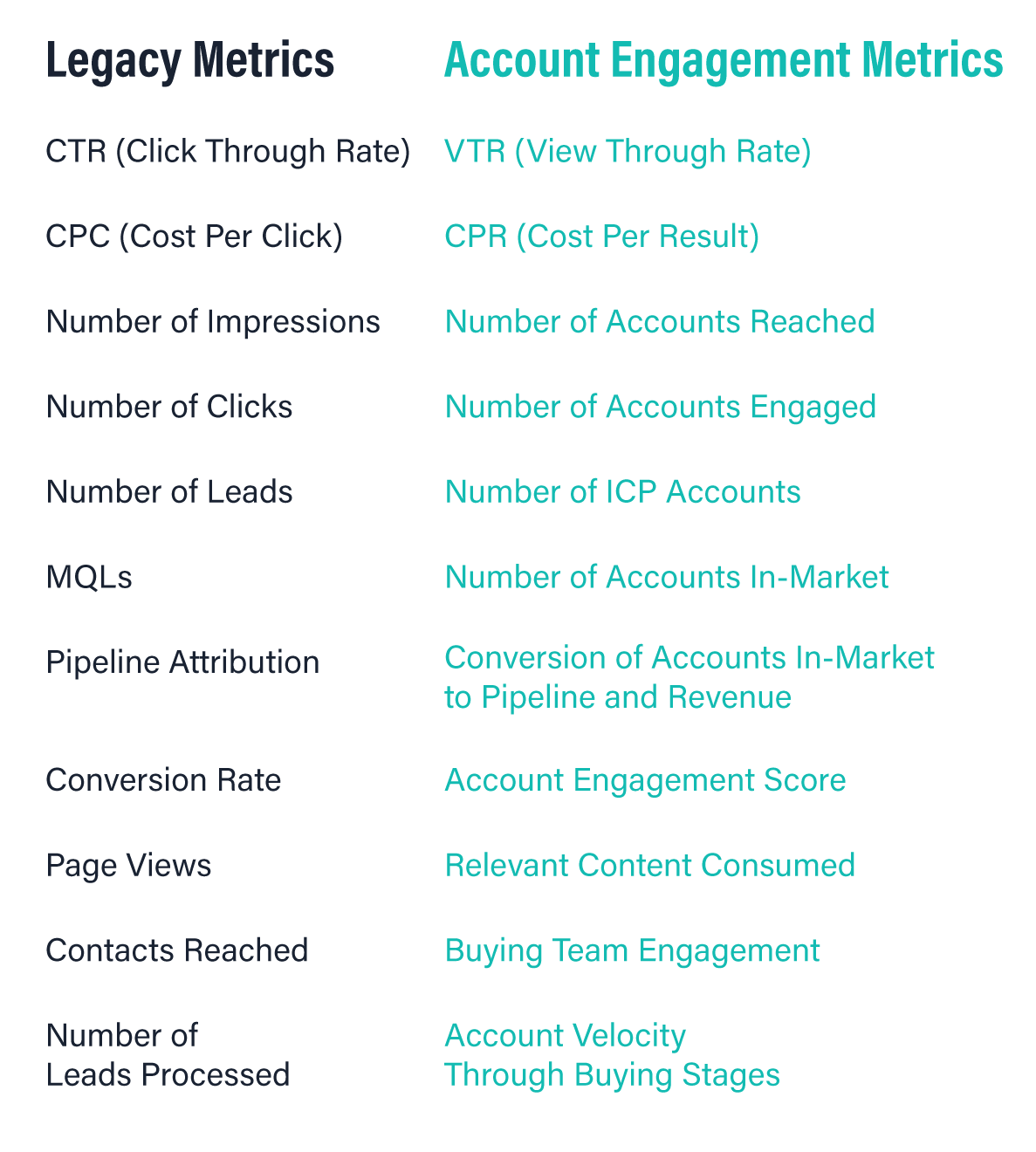1
2
3
4
5
Operationalizing these five steps are the key to unlocking ABX at scale:
The goal for so many marketing teams — particularly the 37% currently in that “working on it” ABM phase — is to stop half-assing it and make that true organizational shift, where the entire revenue team is working in lockstep on an account-based go-to-market plan. We talked about those four ABM roadblocks — The Dark Funnel™, marketing and sales misalignment, gaps in data, and an insufficient or disconnected tech stack — so how do you overcome them in order to finally start delivering true account-based experiences?
5 Commandments of ABM







Select the best accounts
Know about them
Engage the right way
Collaborate with Sales
Track real stuff










A successful account-based approach requires the ability to select accounts based on real buyer intent and activity data lurking in the Dark Funnel, and the ability to model out the buyer journey that leads to a closed/won opportunity based on previous behavior — all of which takes data-crunching power that our limited human brains simply aren’t capable of.
1. Select the best accounts.
In addition to capturing intent signals from every known and anonymous source, we must also be able to easily identify new contacts and build out the complete buying center for those accounts that meet the threshold of being “in-market” for your product. This is what ultimately will allow you to create the targeted micro-segments necessary for ABM success. None of this can be done at scale without a robust CDP and the computing power of AI.
An AI-powered account engagement platform that uses predictive modeling can help you uncover demand and identify (and prioritize) the right in-market accounts.













How many more 3rd-party data sources can we license? Collecting account data including geographic, technographic, and firmographic data, along with personas and contacts, can be difficult, time-consuming, and expensive. And this is table stakes. We also need to know what prospects care about. Are they early stage or late stage? Who are the members of the buying team? All those answers live in the data that we need to extract from the Dark Funnel.
2. Know about them.
You probably have a good idea about the size of your current
TAM (Total Addressable Market), or maybe you’ve even done the
necessary work to establish your ICP (Ideal Customer Profile).
These are both important segments to know and understand, but on their own, do little to enable
your team to execute an effective ABM program at scale — mainly because both are
far too large and offer little insight into which companies are actually looking to buy your product or service today. Adding an extra ‘I’ to that acronym and developing your IICP (In-market Ideal Customer Profile) allows you to prioritize your budget and effort on accounts with the highest propensity to buy.
Imagine trying to manually tweak an ad segment or outbound campaign list to accommodate new accounts moving in or out of a segment based on their buying signals — every single day. There’s just no possible way to do this effectively without AI computing power.
3. Engage the right way.











Overcoming buyer resistance means orchestrating
“always-on” personalized, multi-channel, multi-touch
outreach, based on AI-driven insights. But how do we
get there? The key is to utilize the demand signals we’re capturing to trigger the right campaign, for the right member of the buying team, at the right time, and over their preferred communication channel.
If we want to provide useful information and help our targeted accounts build consensus, we need predictive analytics to understand where they are in the buying journey and what they care about. This requires stitching together millions of signals to understand buying patterns and predict when an account is ready to engage, and advanced orchestration capabilities across multiple personas, channels, and messages at the right times. If we’re dealing with one system for display ads, another for email, and a third for BDR outreach, it’s impossible to
coordinate these efforts at scale, and the likely outcome is a disconnected prospect experience.
An AI-powered account engagement platform allows us to execute high-ROI campaigns that truly engage members of the buying team with the right message at the right time, and helps sales know exactly when to take the next best action — and not just with ten or even fifty accounts, but thousands.
Half of all sales and marketing leaders only somewhat agree (or don’t agree at all) on their target account list; we found that even 42% of successful account-based organizations lack consensus. All too often, marketing and sales teams rely on different datasets, work in different platforms, and track different success metrics.
4. Collaborate with sales.
Remember, with an account-based strategy, marketing and sales should be working toward the same ultimate goals — turning prospects into customers and customers into a steady stream of revenue. But when scaling your ABM efforts to thousands of accounts, each with multiple potential contacts on the buying team, how do you prioritize which accounts to spend time, effort, and budget on today?
Align on the fundamental measurable goals. Sit down with your sales team and talk specifics around the metrics and KPIs you both need to work toward, as well as who’s responsible for accomplishing what, when, and how. Then, AI does the heavy lifting to ensure you’re concentrating resources on accounts with a high buying propensity, by calculating behavioral and fit scores for accounts, leads, and contacts. Ultimately, this gives you the marketer the power to provide your friends in sales the insights they need into each account’s complete buying journey.








As much as we love data, we need to acknowledge that it’s not all created equal. If you’re measuring the wrong things, the resulting information won’t get you very far — and it certainly won’t give you any meaningful insights to help your marketing efforts.
5. Track real stuff.
One mistake many B2B marketing leaders still make is measuring success based on lead-level metrics instead of account-based metrics. But lead scoring point systems are unscientific and not very helpful in predicting an individual’s likelihood of actually purchasing. They don’t measure a buyer’s readiness to make a decision. So even with the world’s best MQL data collection, reporting, and analytics, at the end of the day, you’re left with lots of information but very little insight.
On the other hand, tracking account-based metrics like number of accounts engaged, number of accounts in market, and account velocity through buying stages gives you relevant information you can use. By looking at your historical account-based sales and marketing data — and pairing it with real-time intent and engagement data — you can see when an account meets your ideal customer profile and has just moved to the decision or purchase buying stage. And that’s insight that enables you to predictably grow pipeline and revenue.



















It’s time to move the sales and marketing technology world away from outdated tools, and usher in a new era of B2B platforms that will fundamentally change the way companies go to market. To create alignment and bring the entire revenue team together under one roof, we need to start changing the way we talk about our solutions.
The RevTech Revolution
We're already seeing account-based tech, sales tech, and legacy marketing tech categories beginning to converge into a massive market that will only continue to grow. Now, instead of having separate categories, we’re flying one unified flag, under what we’re calling “RevTech.”
The reality is, ABM is still solid, principled marketing — and it works. But in order to do it (and do it well), you need more than a few automation tools stitched together to unlock the secrets of the Dark Funnel, prioritize for timing, and engage with buyers on their terms. This requires you to collect and analyze terabytes of data to understand prospect behavior that simply cannot be achieved without a robust Customer Data Platform (CDP), Machine Learning, and AI. It also means you need a way to orchestrate how, when, and where to use these buyer insights on a massive, yet individualized scale.
Today’s RevTech platform puts the power of AI behind the entire revenue team, to provide both insights on prospects and customers and the ability to orchestrate the thousands of real-time, micro-actions necessary to deliver an effective account-based strategy at scale.
The right AI-driven RevTech platform allows us to get back to doing what we do best — creating engaging programs that support our customers and prospects in navigating their unique buyer journey, on their terms, and at their pace.



























At 6sense, we’ve been on a mission to fundamentally change the way revenue teams go to market and achieve success, with both our technology and an account-based mindset. But our vision has always been bigger and bolder than merely leading the account-based sales and marketing category, and we see enormous opportunity in rethinking the way B2B companies go to market — using data, insights, and AI-driven predictions.
The 6sense approach
The 6sense platform brings together the best of marketing, sales, RevOps, and customer success capabilities, on top of a common big data and AI-powered orchestration layer, allowing organizations to marshal the full potential of the RevTech stack.
When revenue teams work through their obstacles to embrace a tech-fueled, data-driven, account-based approach, great things happen. And the proof is in the pudding — or ROI, in this case.
6sense customers see a 2X increase in average deal size, 10% improvement in win rate and 25% reduction in cycle time when those super-savvy, super-aligned revenue teams focus on accounts identified by 6sense.
see what Gary Survis has to say about the RevTech Revolution





“Account-based marketing was this great thing to jump on, and it seemed like a good thing to ride for a little while, and then people started realizing it’s not just about marketing, it’s about sales, customer success, etc., and so we started saying “ABX.”
But we need to go a step further and think about this holistic, end-to-end RevTech cycle where you have multiple touchpoints and multiple tools to really up your game to provide bespoke experiences to each kind of customer you’re trying to work with, and you
can’t do that with those point solutions that keep your teams in siloes.
We use terms all the time like orchestration — what a great term — but the reality is, orchestration can be high on concept and low on execution if you don’t think about it end to end. The shift to ‘RevTech’ is that end-to-end vision."


Operating Partner at Insight Partners
Gary Survis
see what Ian Howells has to say about 6sense

“We had a bunch of different point solutions for things like lead scoring and advertising and personalization. But you really need that conductor of the orchestra.
6sense orchestrates everything else and that’s massive for us. Customers want a consistent experience throughout the journey and 6sense helps us create that."
Chief Marketing Officer at Sage Intacct
Ian Howells





Click here for more
Account Engagement Metrics







Nearly 60% of organizations that claim to be "account-based" are still most focused on MQLS.
50% of teams don't believe their lead scoring processes surface the best leads accurately or consistently.




Consider these Metrics

The innovation we’ve been able to deliver to date is a direct result of our history and expertise in big data (and the hard work of mastering, cleansing, and de-duplicating), AI, and machine learning, all of which make 6sense un
iquely different from current sales and marketing technologies. Today, the 6sense platform relies on that foundational core to uniquely match buying signals to accounts more accurately than any other solution, deliver AI-powered predictions for account fit and timing, and help revenue teams execute across every channel.
In other words, you get real, actionable insights about your accounts in real time and learn more about what all those different folks on the buying committee are researching, so you can serve them up a relevant, timely, damn good experience.